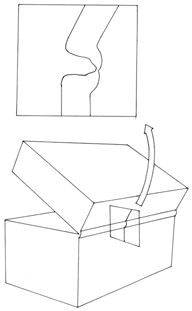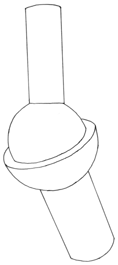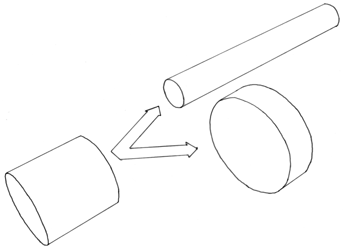A novel type of joint: the muscle articulation
What is a muscle articulation?
First we must define a joint! Aristotle defined a joint as that area between two rigid structures that allows their relative movement. Most scientists studying biomechanics recognize two types of joints: Strap joints and articulated joints.
Strap joints (Fig. 1) are simply a thinning of the material in an area where bending is required. Some simple arthropod joints use this type of joint, but they are relatively rare because the thin cuticle of the joint cannot resist large compression forces.

Figure 1. The hinge of a cheap plastic box: a strap joint is a thinning of the material that is flexible.
Articulated joints (Fig. 2) are more common and widely studied: vertebrate skeletons use them. Articulated joints are created when two rigid skeletal elements (known as links) contact each other. The contact surfaces between these links is known as an articulation. The articulations often have a complicated design, that includes ligaments, tendons and connective tissues, in order to safely and efficiently limit unwanted ranges of motion and transfer forces between the links.

Figure 2. The ball-in-socket joint: an articulated joint in which two links contact each other at the ball and the socket. Ball-in-socket joints have a wide range of motion (many degrees of freedom) they can rotate and swivel from side to side in any direction.
Thus, an effective joint must be capable of allowing appropriate motion while safely transmitting a potentially diverse array of forces. Muscle articulations are neither strap nor an articulated joints because the links are not connected by a flexible skeletal material nor are there any contact points to transmit force. Muscle articulations are links that are embedded in a mass of muscle and connective tissue. The muscle fibers may function as a muscular hydrostat, in which fibers are arranged in a tightly packed three-dimensional array. In such an array, the contraction of one orientation of muscle fibers changes the shape of the array, creating deformation and movement and lengthening antagonistic muscle fibers of another orientation (Fig. 3). Thus, in muscle articulations, the muscle tissue in which the rigid links are embedded must function as a joint while also generating the force that moves the links relative to each other. So, the definition of a "muscle articulation" is a joint in which the muscle serves this dual function because the rigid skeletal elements themselves never contact each other at an articulating surface.

Figure 3. A muscular hydrostat. This cylinder may conform to different lengths and diameters while maintaining a constant volume by virtue of antagonistic muscle fibers of varying orientations.
The muscle articulation represents a new type of flexible joint that is formed of muscle and connective tissues in such a way that it allows for a complexity and diversity of movements that is often unparalleled in previously studied vertebrate joints. They may be extremely important in the movements and behaviors of many phyla of soft bodied invertebrates, such as octopuses, marine annelid worms and flatworms. For more information on the morphology and function of muscle articulations please see my publications list.

Project Areas
Gastropods |
Muscle Articulations |
Bullfrogs |
The Heart |
Techniques |